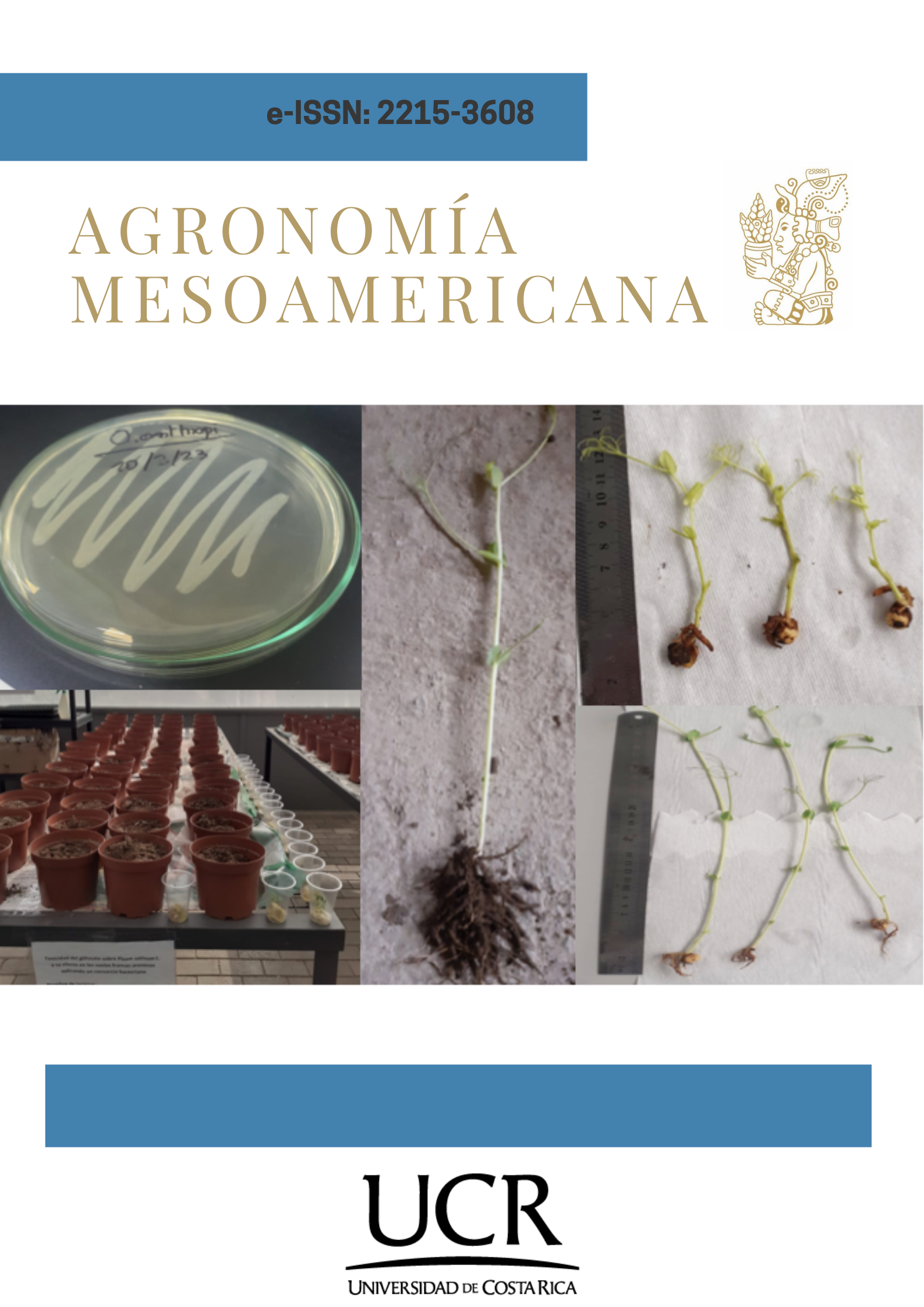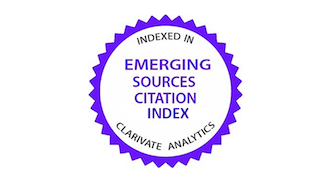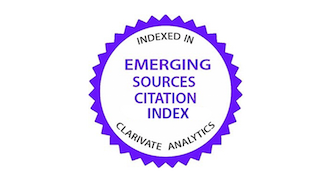Toxicity of glyphosate on snow pea (Pisum sativum) in sandy-loam soil with a bacterial consortium
DOI:
https://doi.org/10.15517/am.2025.63041Keywords:
herbicide, microorganism, Ochrobactrum anthropi, Pseudomonas aeruginosa, soil biologyAbstract
Introduction. Glyphosate (GLI) is a widely used herbicide that, when applied in excess, can affect both
broadleaf weeds and crops. Plant growth-promoting bacteria may enhance crop resistance and protection against GLI effects. Objective. To evaluate GLI toxicity on the root, stem, and combined root + stem of Pisum sativum in sandy loam soil, in the presence of Ochrobactrum anthropi and Pseudomonas aeruginosa, both individually and as a bacterial consortium composed of both microorganisms. Materials and methods. The experiment was conducted in a greenhouse in Lima, Peru, using a completely randomized design with 32 treatments. Soil was mixed with GLI and subjected to edaphological analysis. Four treatments served as controls, twelve contained soil with O. anthropi and P. aeruginosa individually and on their bacterial consortium, and sixteen treatments included P. sativum. Results. P. sativum exposed to 8.71 mL L-1 and 17.42 mL L-1 of GLI showed a significant growth reduction, particularly in fresh
stem and root biomass. However, bacterial consortium reversed this effect and improved growth. GLI altered soil pH and electrical conductivity, while organic matter remain unchanged. Soil available potassium increased with GLI, but bacterial presence reduced this effect. Available phosphorus increased in treatments combining P. sativum and GLI at 17.42 mL L-1. Conclusions. Higher GLI concentrations negatively impacted P. sativum stem and root growth, but bacterial inoculation attenuated these effects and modified soil properties. These findings highlight the relevance of the interaction between herbicide, microorganisms, and soil parameters in agriculture.
References
Abahonza de la Cruz, D. V., Benavides Mejía, O. A., Fajardo Escobar, C. P., & Huertas Delgado, J. L. (2022). Remediación de suelos degradados con glifosato a partir de enmiendas orgánicas a escala laboratorio. En J. L. Huertas Delgado, L. N. Torres Martinez, L. G. Lafaurie Ponce, & J. E. Insuasty Enríquez (Eds.), Las ciencias ambientales y su avance sin fronteras durante la pandemia (pp. 153–167). Editorial Unimar. https://doi.org/10.31948/editorialunimar.171.c222 DOI: https://doi.org/10.31948/editorialunimar.171.c222
Ali, S., Abbas, Z., Rizwan, M., Zaheer, I. E., Yavaş, İ., Ünay, A., Abdel-Daim, M. M., Bin-Jumah, M., Hasanuzzaman, M., & Kalderis, D. (2020). Application of floating aquatic plants in phytoremediation of heavy metals polluted water: a review. Sustainability, 12(5), Article 1927. https://doi.org/10.3390/su12051927 DOI: https://doi.org/10.3390/su12051927
Arispe-Vázquez, J. L., Cadena-Zamudio, D. A., Tamayo-Esquer, L. M., Noriega-Cantú, D. H., Toledo-Aguilar, R., Felipe-Victoriano, M., Barrón-Bravo, O. G., Reveles-Hernández, M., Ramírez-Sánchez, S. E., & Espinoza-Ahumada, C. A. (2023). A review of the current panorama of glyphosate resistance among weeds in Mexico and the rest of the world. Agro Productividad, 16(7), 135–149. https://doi.org/10.32854/agrop.v16i7.2618 DOI: https://doi.org/10.32854/agrop.v16i7.2618
Badii, M. H., & Varela, S. (2015). Insecticidas organofosforados: efectos sobre la salud y el ambiente. CULCYT, Cultura Científica y Tecnológica, 28(5), 5–17. https://erevistas.uacj.mx/ojs/index.php/culcyt/article/view/375
Bhatt, P., Bhatt, K., Sharma, A., Zhang, W., Mishra, S., & Chen, S. (2021). Biotechnological basis of microbial consortia for the removal of pesticides from the environment. Critical Reviews in Biotechnology, 41(3), 317–338. https://doi.org/10.1080/07388551.2020.1853032 DOI: https://doi.org/10.1080/07388551.2020.1853032
Burbano-Orjuela, H. (2016). El suelo y su relación con los servicios ecosistémicos y la seguridad alimentaria. Revista de Ciencias Agrícolas, 33(2), 117–124. https://doi.org/10.22267/rcia.163302.58 DOI: https://doi.org/10.22267/rcia.163302.58
Cantaro Segura, H. B. (2019). Reguladores de crecimiento en el cultivo de arveja (Pisum sativum L.) cv. Rondo en La Molina [Tesis de maestría, Universidad Nacional Agraria La Molina]. Repositorio Institucional de la Universidad Nacional Agraria La Molina. https://repositorio.lamolina.edu.pe/handle/20.500.12996/3893
Carrero, A., Zambrano, A., Hernández, E., Contreras, F., Machado, D., Bianchi, G., & Varela, R. (2015). Comparación de dos métodos de extracción de fósforo disponible en un suelo ácido. Avances en Química, 10(Especial), 29–33. http://erevistas.saber.ula.ve/index.php/avancesenquimica/article/view/6931
Castrejón-Godínez, M. L., Tovar-Sánchez, E., Valencia-Cuevas, L., Rosas-Ramírez, M. E., Rodríguez, A., & Mussali-Galante, P. (2021). Glyphosate pollution treatment and microbial degradation alternatives, a review. Microorganisms, 9(11), Article 2322. https://doi.org/10.3390/microorganisms9112322 DOI: https://doi.org/10.3390/microorganisms9112322
Chávez-Ortiz, P., Tapia-Torres, Y., Larsen, J., & García-Oliva, F. (2022). Glyphosate-based herbicides alter soil carbon and phosphorus dynamics and microbial activity. Applied Soil Ecology, 169, Article 104256. https://doi.org/10.1016/j.apsoil.2021.104256 DOI: https://doi.org/10.1016/j.apsoil.2021.104256
Cheloufi, R., Messaadia, H., & Alayat, H. (2017). Biodegradation of herbicides by Pseudomonas aeruginosa in two soils types of the Bou Namoussa irrigable perimeter (Algerian Extreme Northeast): Effects on mineral nutrition (P2O5 and NO3). Journal of Materials and Environmental Science, 8(7), 2513–2521. https://www.jmaterenvironsci.com/Document/vol8/vol8_N7/270-JMES-2713-Cheloufi.pdf
Dawood, M. G., Abdel-Baky, Y. R., El-Awadi, M. E. S., & Bakhoum, G. S. (2019). Enhancement quality and quantity of faba bean plants grown under sandy soil conditions by nicotinamide and/or humic acid application. Bulletin of the National Research Centre, 43, Article 28. https://doi.org/10.1186/s42269-019-0067-0 DOI: https://doi.org/10.1186/s42269-019-0067-0
Ezaka, E., Akintokun, A. K., Akintokun, P. O., Taiwo, L. B., Uthman, A. C. O., Oyedele, O. A., & Aluko, O. I. (2018). Glyphosate degradation by two plant growth promoting bacteria (PGPB) isolated from rhizosphere of maize. Microbiology Research Journal International, 26(6), 1–11. https://doi.org/10.9734/mrji/2018/v26i630081 DOI: https://doi.org/10.9734/mrji/2018/v26i630081
Fernandes, B., Soares, C., Braga, C., Rebotim, A., Ferreira, R., Ferreira, J., Fidalgo, F., Pereira, R., & Cachada, A. (2020). Ecotoxicological assessment of a glyphosate-based herbicide in cover plants: Medicago sativa L. as a model species. Applied Sciences, 10(15), Article 5098. https://doi.org/10.3390/app10155098 DOI: https://doi.org/10.3390/app10155098
Góngora Echeverría, V. R., García Escalante, R., Rojas Herrera, R., Giácoman Vallejos, G., & Ponce Caballero, C. (2020). Pesticide bioremediation in liquid media using a microbial consortium and bacteria-pure strains isolated from a biomixture used in agricultural areas. Ecotoxicology and Environmental Safety, 200, Article 110734. https://doi.org/10.1016/j.ecoenv.2020.110734 DOI: https://doi.org/10.1016/j.ecoenv.2020.110734
González Ortega, E., & Fuentes Ponce, M. H. (2022). Dinámica del glifosato en el suelo y sus efectos en la microbiota. Revista Internacional de Contaminación Ambiental, 38, 127–144. https://doi.org/10.20937/RICA.54197 DOI: https://doi.org/10.20937/RICA.54197
Grewal, K., Kumar, S., Amin Bhat, M., & Dinesh. (2017). Comparison of chemical extractants for determination of available potassium. International Journal of Chemical Studies, 5(6), 417–423. https://www.chemijournal.com/archives/2017/vol5issue6/PartF/5-5-369-532.pdf
Gustinasari, K., Pandebesie, E. S., Syafei, A. D., & Hermana, J. (2021). Phytotoxicity of glyphosate-based herbicide to Typha angustifolia and Vetiveria zizanioides and its effect on rhizosphere bacteria. Nanotechnology for Environmental Engineering, 6(3), Article 45. https://doi.org/10.1007/s41204-021-00140-1 DOI: https://doi.org/10.1007/s41204-021-00140-1
Gutiérrez, R. E., & Cáceres, C. A. (2018). Correlación entre la conductividad eléctrica medida en el extracto de saturación del suelo y en extractos con cinco relaciones suelo agua. ALFA, 2(6), 144–156. https://doi.org/10.33996/revistaalfa.v2i6.46 DOI: https://doi.org/10.33996/revistaalfa.v2i6.46
Hébert, M.-P., Fugère, V., & Gonzalez, A. (2018). The overlooked impact of rising glyphosate use on phosphorus loading in agricultural watersheds. Frontiers in Ecology and the Environment, 17(1), 48–56. https://doi.org/10.1002/fee.1985 DOI: https://doi.org/10.1002/fee.1985
Heck, K., De Marco, É. G., Duarte, M. W., Salamoni, S. P., & Van Der Sand, S. (2015). Pattern of multiresistant to antimicrobials and heavy metal tolerance in bacteria isolated from sewage sludge samples from a composting process at a recycling plant in southern Brazil. Environmental Monitoring and Assessment, 187(6), Article 328. https://doi.org/10.1007/s10661-015-4575-6 DOI: https://doi.org/10.1007/s10661-015-4575-6
Hou, W. J., Zou, M., Li, B. F., & Yu, Y. C. (2020). Effect of glyphosate on soil physicochemical properties of Eucalyptus plantations. Scientia Silvae Sinicae, 56(8), 20–26. https://doi.org/10.11707/j.1001-7488.20200803
Hove-Jensen, B., Zechel, D. L., & Jochimsen, B. (2014). Utilization of glyphosate as phosphate source: biochemistry and genetics of bacterial carbon-phosphorus lyase. Microbiology and Molecular Biology Reviews, 78(1), 176–197. https://doi.org/10.1128/mmbr.00040-13 DOI: https://doi.org/10.1128/MMBR.00040-13
Izquierdo Bautista, J., & Arévalo Hernández, J. J. (2021). Determinación del carbono orgánico por el método químico y por calcinación. Ingeniería y Región, 26(2), 20–28. https://doi.org/10.25054/22161325.2527 DOI: https://doi.org/10.25054/22161325.2527
Ledoux, M. L., Hettiarachchy, N., Yu, X., Howard, L., & Sun-Ok, L. (2020). Penetration of glyphosate into the food supply and the incidental impact on the honey supply and bees. Food Control, 109, Article 106859. https://doi.org/10.1016/j.foodcont.2019.106859 DOI: https://doi.org/10.1016/j.foodcont.2019.106859
Lizarbe Alache, L. E., Vega Córdova, E. A., & Lizarbe Córdova, J. A. (2020). Adaptación y eficiencia agronómica en el maíz amarillo duro (Zea mays L.) en diferentes localidades de la costa central y norte del Perú. Boletín Redipe, 9(11), 260–271. https://doi.org/10.36260/rbr.v9i11.1129 DOI: https://doi.org/10.36260/rbr.v9i11.1129
Merani, V. H., Millan, G. J., Ferro, D. A., Larrieu, L., Bennardi, D., Polich, N., Juan, L., & Bongiorno, F. M. (2019). Comparación de metodologías de determinación de la conductividad eléctrica y concentración iónica en suelos de la provincia de Buenos Aires. Ciencias Agronómicas, 19, Article e003. https://doi.org/10.35305/agro34.277 DOI: https://doi.org/10.35305/agro34.277
Mertens, M., Höss, S., Neumann, G., Afzal, J., & Reichenbecher, W. (2018). Glyphosate, a chelating agent-relevant for ecological risk assessment? Environmental Science and Pollution Research, 25(6), 5298–5317. https://doi.org/10.1007/s11356-017-1080-1 DOI: https://doi.org/10.1007/s11356-017-1080-1
Ministerio del Ambiente. (2014). Guía para el muestreo de suelos y la guía para la elaboración de planes de descontaminación de suelos (Resolución Ministerial N° 085-2014-MINAM). https://www.minam.gob.pe/disposiciones/resolucion-ministerial-n-085-2014-minam/
Mohy-Ud-Din, W., Chen, F., Bashir, S., Akhtar, M. J., Asghar, H. N., Farooqi, Z. U. R., Zulfiqar, U., Haider, F. U., Afzal, A., & Alqahtani, M. D. (2023). Unlocking the potential of glyphosate-resistant bacterial strains in biodegradation and maize growth. Frontiers in Microbiology, 14, Article 1285566. https://doi.org/10.3389/fmicb.2023.1285566 DOI: https://doi.org/10.3389/fmicb.2023.1285566
Morrás, H., Behrends Kraemer, F., Sainz, D., Fernández, P., & Chagas, C. (2022). Soil structure and glyphosate fate under no-till management in the Pampa region. II. Glyphosate and AMPA persistence and spatial distribution in the long-term. A conceptual model. Soil and Tillage Research, 223, Article 105471. https://doi.org/10.1016/j.still.2022.105471 DOI: https://doi.org/10.1016/j.still.2022.105471
Obour, A. K., Stahlman, P. W., & Holman, J. D. (2016). Soil chemical properties as influenced by long-term glyphosate-resistant corn and soybean production in the central Great Plains, USA. Geoderma, 277, 1–9. https://doi.org/10.1016/j.geoderma.2016.04.029 DOI: https://doi.org/10.1016/j.geoderma.2016.04.029
Pedemonte Castro, F. E. (2017). Problemática del uso de glifosato [Tesis de grado, Universidad Nacional Agraria La Molina]. Repositorio Institucional de la Universidad Nacional Agraria La Molina. https://repositorio.lamolina.edu.pe/handle/20.500.12996/3011
Pronk, G. J., Heister, K., Vogel, C., Babin, D., Bachmann, J., Ding, G.-C., Ditterich, F., Gerzabek, M. H., Giebler, J., Hemkemeyer, M., Kandeler, E., Kunhi Mouvenchery, Y., Miltner, A., Poll, C., Schaumann, G. E., Smalla, K., Steinbach, A., Tanuwidjaja, I., Tebbe, C. C., … Kögel-Knabner, I. (2017). Interaction of minerals, organic matter, and microorganisms during biogeochemical interface formation as shown by a series of artificial soil experiments. Biology and Fertility of Soils, 53(1), 9–22. https://doi.org/10.1007/s00374-016-1161-1 DOI: https://doi.org/10.1007/s00374-016-1161-1
Romano-Armada, N., Amoroso, M. J., & Rajal, V. B. (2019). Construction of a combined soil quality indicator to assess the effect of glyphosate application. Science of the Total Environment, 682, 639–649. https://doi.org/10.1016/j.scitotenv.2019.05.079 DOI: https://doi.org/10.1016/j.scitotenv.2019.05.079
Rossi, F., Carles, L., Donnadieu, F., Batisson, I., & Artigas, J. (2021). Glyphosate-degrading behavior of five bacterial strains isolated from stream biofilms. Journal of Hazardous Materials, 420, Article 126651. https://doi.org/10.1016/j.jhazmat.2021.126651 DOI: https://doi.org/10.1016/j.jhazmat.2021.126651
Shahid, M., Ahmed, B., Zaidi, A., & Khan, M. S. (2018). Toxicity of fungicides to Pisum sativum: A study of oxidative damage, growth suppression, cellular death and morpho-anatomical changes. RSC Advances, 67, 38483–38498. https://doi.org/10.1039/c8ra03923b DOI: https://doi.org/10.1039/C8RA03923B
Silva, F. M. L., Duke, S. O., Dayan, F. E., & Velini, E. D. (2016). Low doses of glyphosate change the responses of soyabean to subsequent glyphosate treatments. Weed Research, 56(2), 124–136. https://doi.org/10.1111/wre.12189 DOI: https://doi.org/10.1111/wre.12189
Singh, S., Kumar, V., Gill, J. P. K., Datta, S., Singh, S., Dhaka, V., Kapoor, D., Wani, A. B., Dhanjal, D. S., Kumar, M., Harikumar, S. L., & Singh, J. (2020). Herbicide glyphosate: Toxicity and microbial degradation. International Journal of Environmental Research and Public Health, 17(20), Article 7519. https://doi.org/10.3390/ijerph17207519 DOI: https://doi.org/10.3390/ijerph17207519
Singh, S., Kumar, V., Sidhu, G. K., Datta, S., Singh Dhanjal, D., Koul, B., Singh Janeja, H., & Singh, J. (2019). Plant growth promoting rhizobacteria from heavy metal contaminated soil promote growth attributes of Pisum sativum L. Biocatalysis and Agricultural Biotechnology, 17, 665–671. https://doi.org/10.1016/j.bcab.2019.01.035 DOI: https://doi.org/10.1016/j.bcab.2019.01.035
Smedbol, É., Lucotte, M., Maccario, S., Gomes, M. P., Paquet, S., Moingt, M., Mercier, L. L. C., Sobarzo, M. R. P., & Blouin, M.-A. (2019). Glyphosate and Aminomethylphosphonic Acid Content in Glyphosate-Resistant Soybean Leaves, Stems, and Roots and Associated Phytotoxicity Following a Single Glyphosate-Based Herbicide Application. Journal of Agricultural and Food Chemistry, 67(22), 6133–6142. https://doi.org/10.1021/acs.jafc.9b00949 DOI: https://doi.org/10.1021/acs.jafc.9b00949
Suwardji, S., & Sudantha, I. M. (2021). The fate of glyphosate in soil and water: A review. Jurnal Penelitian Pendidikan IPA, 7(Special Issue), 389–399. https://doi.org/10.29303/jppipa.v7iSpecialIssue.971 DOI: https://doi.org/10.29303/jppipa.v7iSpecialIssue.971
Tofiño Rivera, A. P., Carbono Murgas, R. E., Melo Ríos, A. E., & Merini, L. J. (2020). Efecto del glifosato sobre la microbiota, calidad del suelo y cultivo de frijol biofortificado en el departamento del Cesar, Colombia. Revista Argentina de Microbiología, 52(1), 61–71. https://doi.org/10.1016/j.ram.2019.01.006 DOI: https://doi.org/10.1016/j.ram.2019.01.006
Villarreal, R. (2018). Variación temporal de las propiedades físicas del suelo y su impacto en la dinámica del glifosato en suelos bajo siembra directa y labranza convencional [Tesis de doctorado, Universidad Nacional de La Plata]. Repositorio SEDICI de la Universidad Nacional de La Plata. https://sedici.unlp.edu.ar/handle/10915/72021
Xu, X., Luo, Q., Zhang, N., Wu, Y., Wei, Q., Huang, Z., & Dong, C. (2024). Sandy loam soil maintains better physicochemical parameters and more abundant beneficial microbiomes than clay soil in Stevia rebaudiana cultivation. PeerJ, 12, Article e18010. https://doi.org/10.7717/peerj.18010 DOI: https://doi.org/10.7717/peerj.18010

Additional Files
Published
License

This work is licensed under a Creative Commons Attribution-NonCommercial-NoDerivatives 4.0 International License.
1. Proposed policy for open access journals
Authors who publish in this journal accept the following conditions:
a. Authors retain the copyright and assign to the journal the right to the first publication, with the work registered under the attribution, non-commercial and no-derivative license from Creative Commons, which allows third parties to use what has been published as long as they mention the authorship of the work and upon first publication in this journal, the work may not be used for commercial purposes and the publications may not be used to remix, transform or create another work.
b. Authors may enter into additional independent contractual arrangements for the non-exclusive distribution of the version of the article published in this journal (e.g., including it in an institutional repository or publishing it in a book) provided that they clearly indicate that the work was first published in this journal.
c. Authors are permitted and encouraged to publish their work on the Internet (e.g. on institutional or personal pages) before and during the review and publication process, as it may lead to productive exchanges and faster and wider dissemination of published work (see The Effect of Open Access).






























